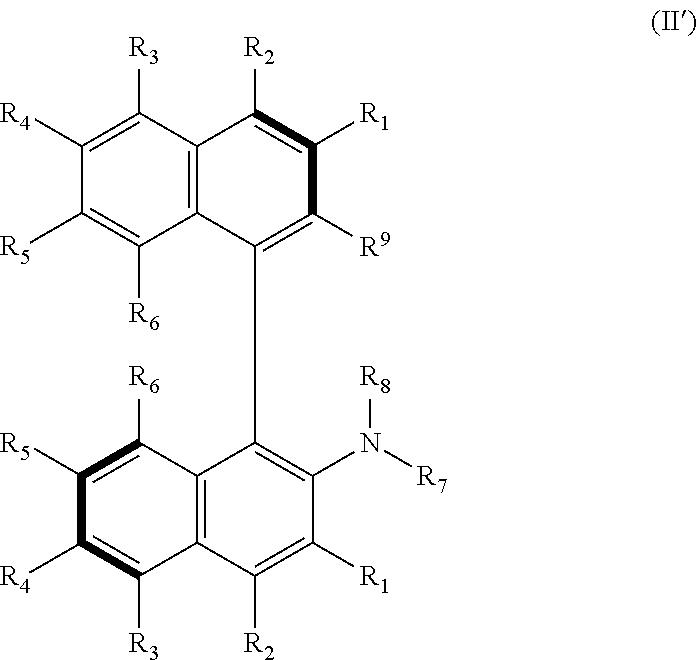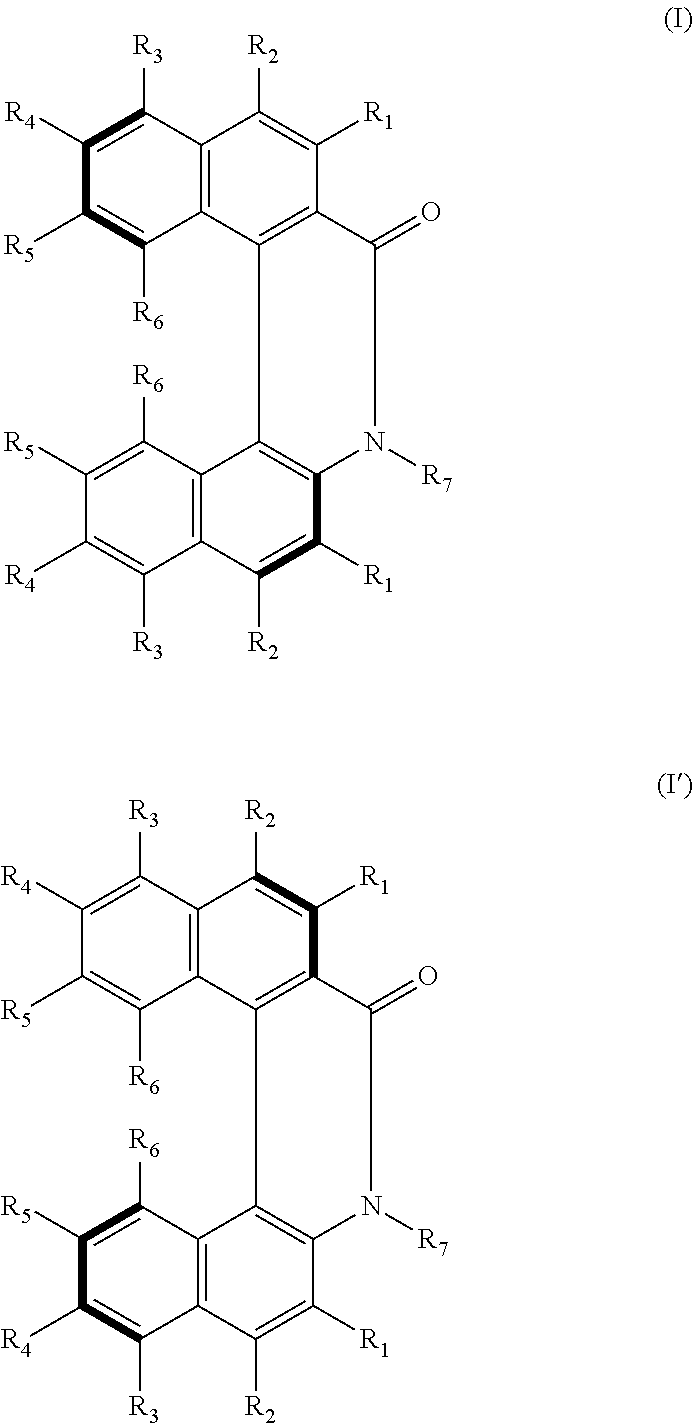Helicene derivative, axially asymmetric amino acid, amine or aminoalcohol derivative, perylene derivative or salt thereof, and methods for producing same
a technology of helicenes and derivatives, applied in the direction of organic compounds/hydrides/coordination complexes, physical/chemical process catalysts, organic chemistry, etc., can solve the problems of difficult synthesis of helicenes in large quantities and the lik
- Summary
- Abstract
- Description
- Claims
- Application Information
AI Technical Summary
Benefits of technology
Problems solved by technology
Method used
Image
Examples
example 1
[0063]Synthesis of N-benzyl-1-bromo-2-naphthamide (2)
[0064]SOCl2 (0.090 mL, 1.31 mmol) and a catalytic amount of DMF were added to a toluene solution (4.5 mL) of 1-bromo-2-naphthoic acid (1) (300 mg, 1.19 mmol) in an Ar atmosphere, followed by stirring at 80° C. for 2 hours. After distilling off the reaction liquid under reduced pressure, the residue was dissolved in CH2Cl2 (4.0 mL). Benzylamine (0.16 mL, 1.43 mmol) and Et3N (0.50 mL, 3.58 mmol) were added to the dissolution at 0° C., and the mixture was then stirred at room temperature for 15 hours. After adding water, the mixture was subjected to extraction using CH2Cl2 three times, washed with a saturated sodium hydrogencarbonate aqueous solution, 2N aq. HCl, and a saturated sodium chloride solution, dried over MgSO4, and then condensed under reduced pressure. Colorless crystal N-benzyl-1-bromo-2-naphthamide (2) (362 mg, 89%) was thus obtained. 1H NMR (270 MHz, CDCl3): δ8.33 (d, J=8.1 Hz, 1H), 7.90-7.80 (m, 2H), 7.70-7.20 (m, 8H)...
example 2
[0068]Synthesis of 1-bromo-N-(4-methoxybenzyl)-2-naphthamide (6)
[0069]SOCl2 (0.31 mL, 4.38 mmol) and a catalytic amount of DMF were added to a toluene solution (10 mL) of 1-bromo-2-naphthoic acid (1) (1.00 g, 3.98 mmol) in an Ar atmosphere, and the mixture was stirred at 75° C. for 4 hours. After distilling the reaction liquid off under reduced pressure, the residue was dissolved in CH2Cl2 (4.0 mL). p-Methoxybenzylamine (0.62 mL, 4.78 mmol) and Et3N (1.68 mL, 11.9 mmol) were added to the solution at 0° C., and the mixture was stirred at room temperature for 2 hours. After adding a saturated sodium hydrogencarbonate aqueous solution, the mixture was subjected to extraction using AcOEt 4 times, washed with a saturated ammonium chloride aqueous solution and a saturated sodium chloride solution, dried over MgSO4, and then condensed under reduced pressure. The crude product thus obtained was recrystallized using toluene-hexane, and the resulting crystal was washed with a small amount of ...
example 3
[0081]Synthesis of 3-(pyridin-4-yl)dibenzo[a,k]phenanthridin-4(3H)-one (18)
[0082]Diglyme (1.0 mL) was added to dibenzo[a,k]phenanthridin-4(3H)-one (8) (20 mg, 0.07 mmol), 4-bromopyridine HCl salt (41 mg, 0.21 mmol), and Cs2CO3 (91 mg, 0.28 mmol) in an Ar atmosphere, and the mixture was stirred at room temperature for 5 minutes. Subsequently, CuI (20 mg, 0.11 mmol), N,N′-dimethylethylenediamine (15 μL, 0.14 mmol), and DMF (3.0 mL) were added to the mixture, and the resulting mixture was stirred at 120° C. for 27 hours. After adding a saturated ammonium chloride aqueous solution to the reaction liquid, extraction using ethyl acetate was performed. The resulting organic layer was washed with a saturated NaHCO3 aqueous solution and a saturated sodium chloride solution, dried over Na2SO4, and the solvent was then distilled off under reduced pressure. The residue was purified using silica gel column chromatography (hexane:ethyl acetate=1:1), obtaining 3-(pyridin-4-yl)dibenzo[a,k]phenanthr...
PUM
 Login to View More
Login to View More Abstract
Description
Claims
Application Information
 Login to View More
Login to View More - R&D
- Intellectual Property
- Life Sciences
- Materials
- Tech Scout
- Unparalleled Data Quality
- Higher Quality Content
- 60% Fewer Hallucinations
Browse by: Latest US Patents, China's latest patents, Technical Efficacy Thesaurus, Application Domain, Technology Topic, Popular Technical Reports.
© 2025 PatSnap. All rights reserved.Legal|Privacy policy|Modern Slavery Act Transparency Statement|Sitemap|About US| Contact US: help@patsnap.com



